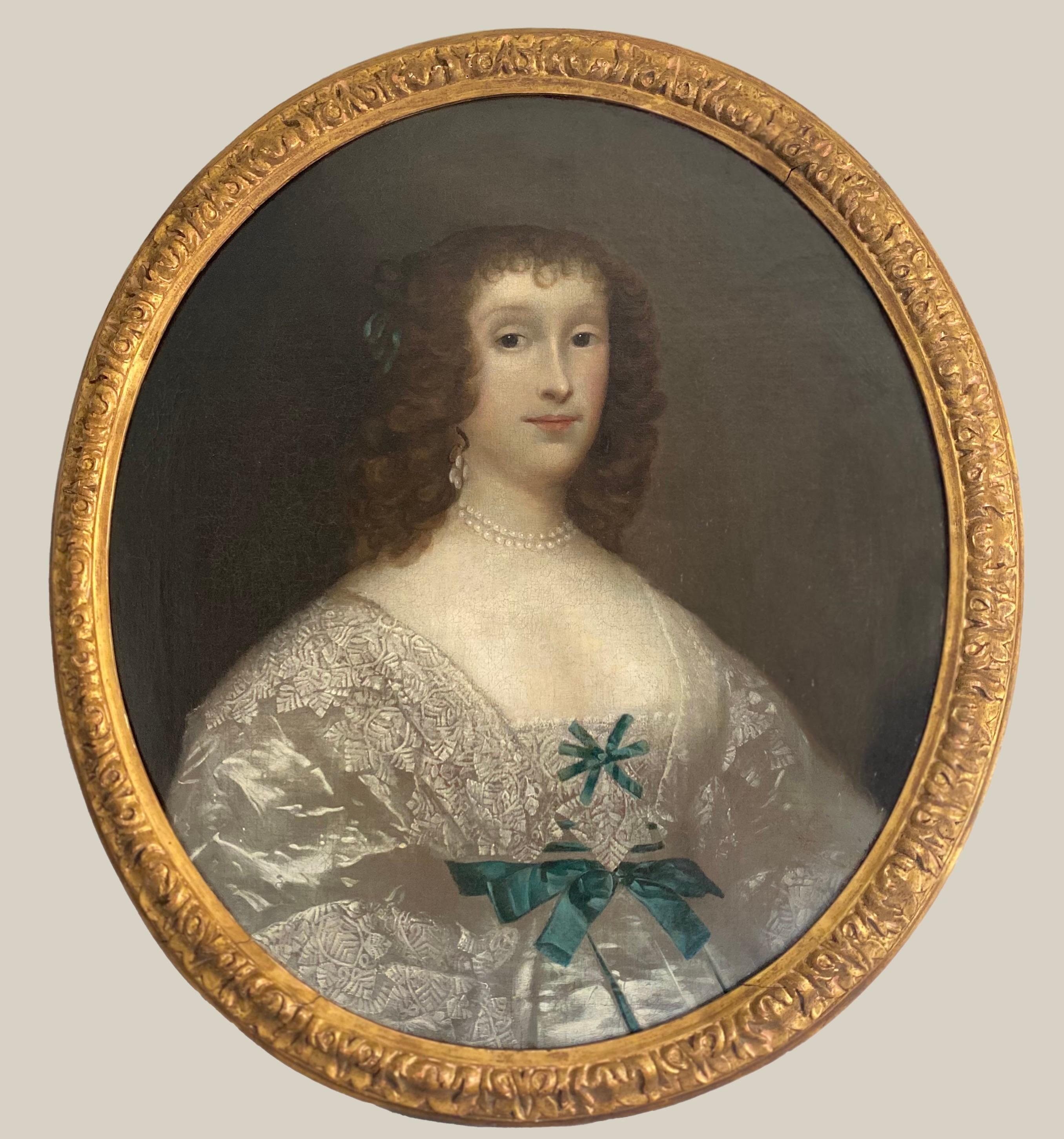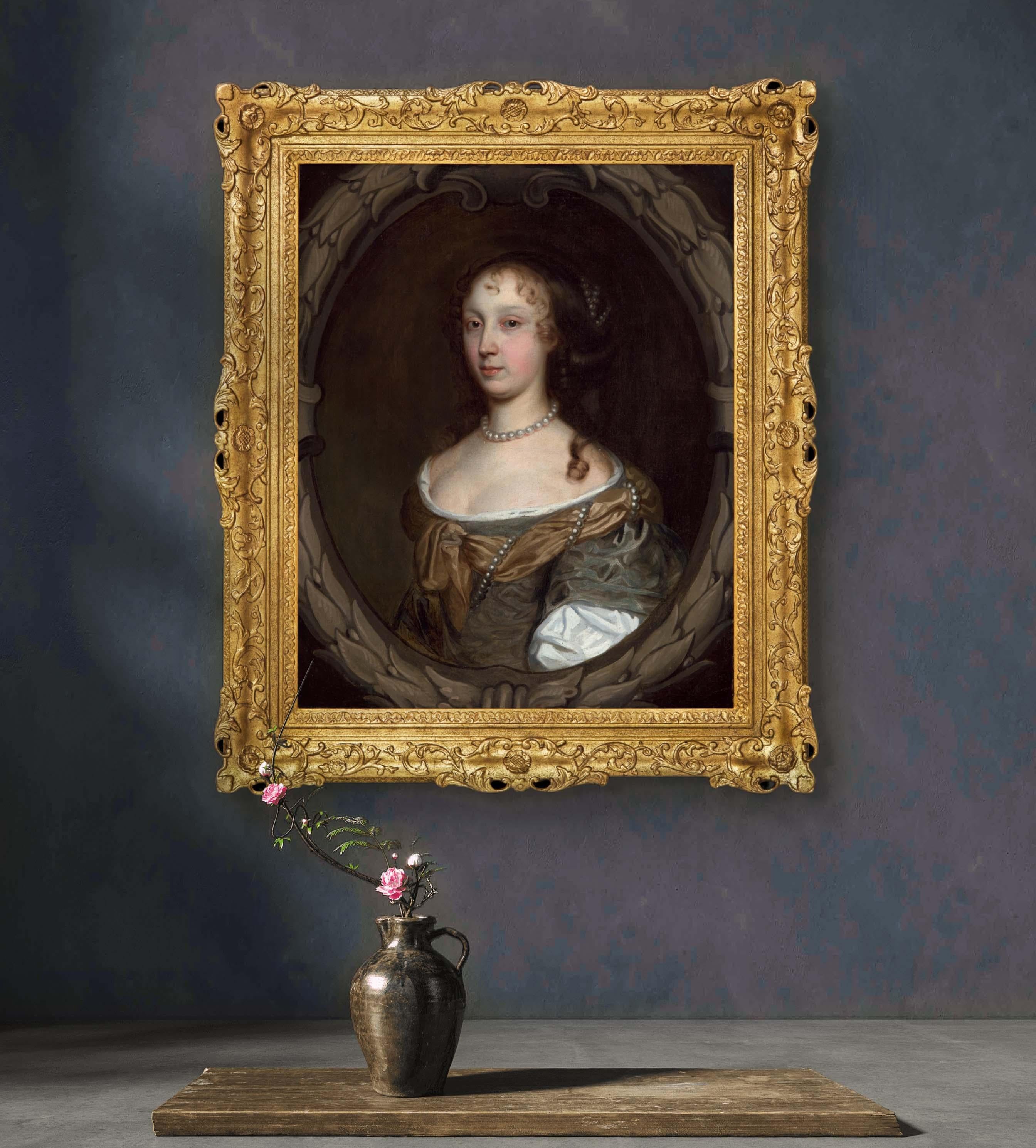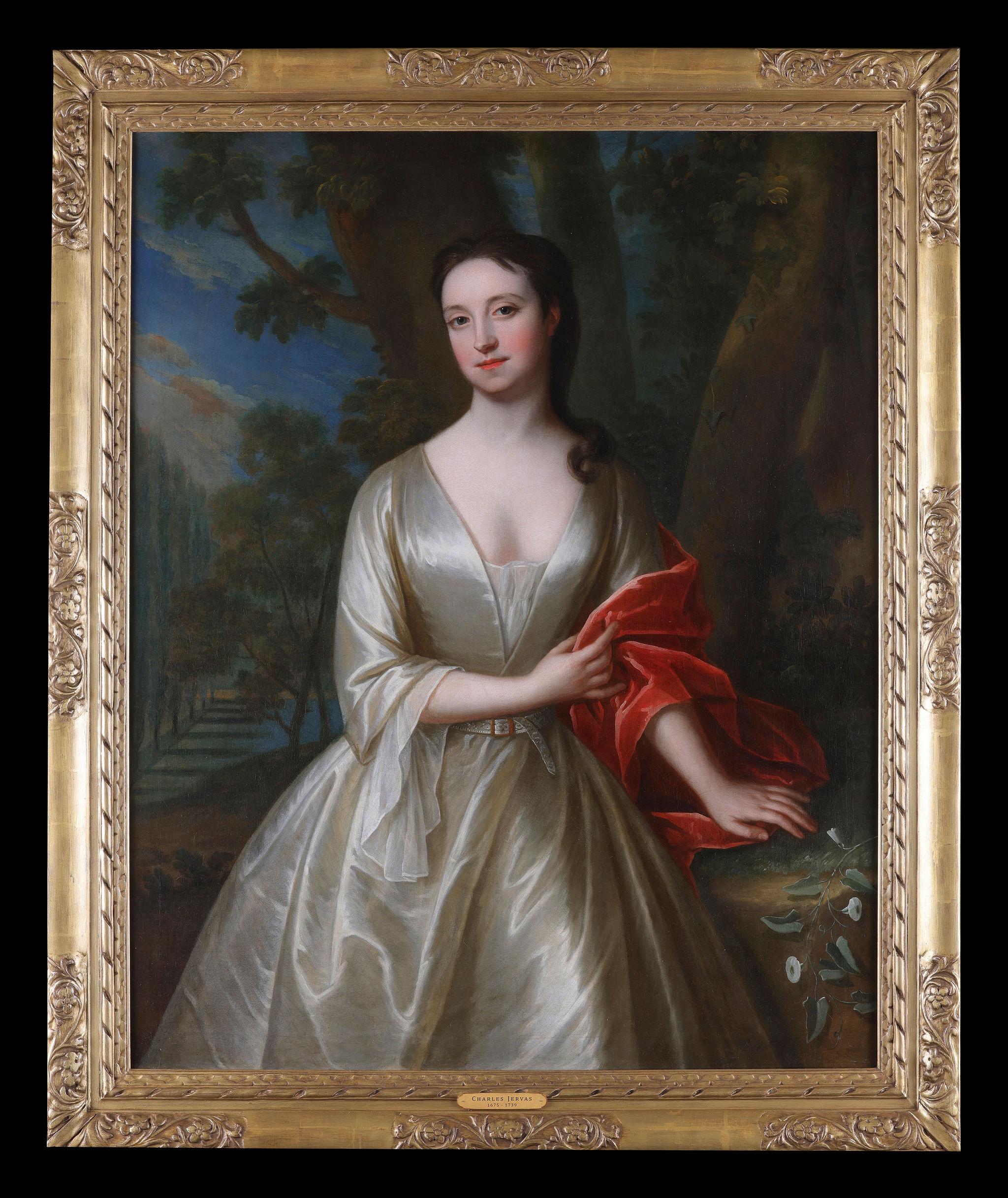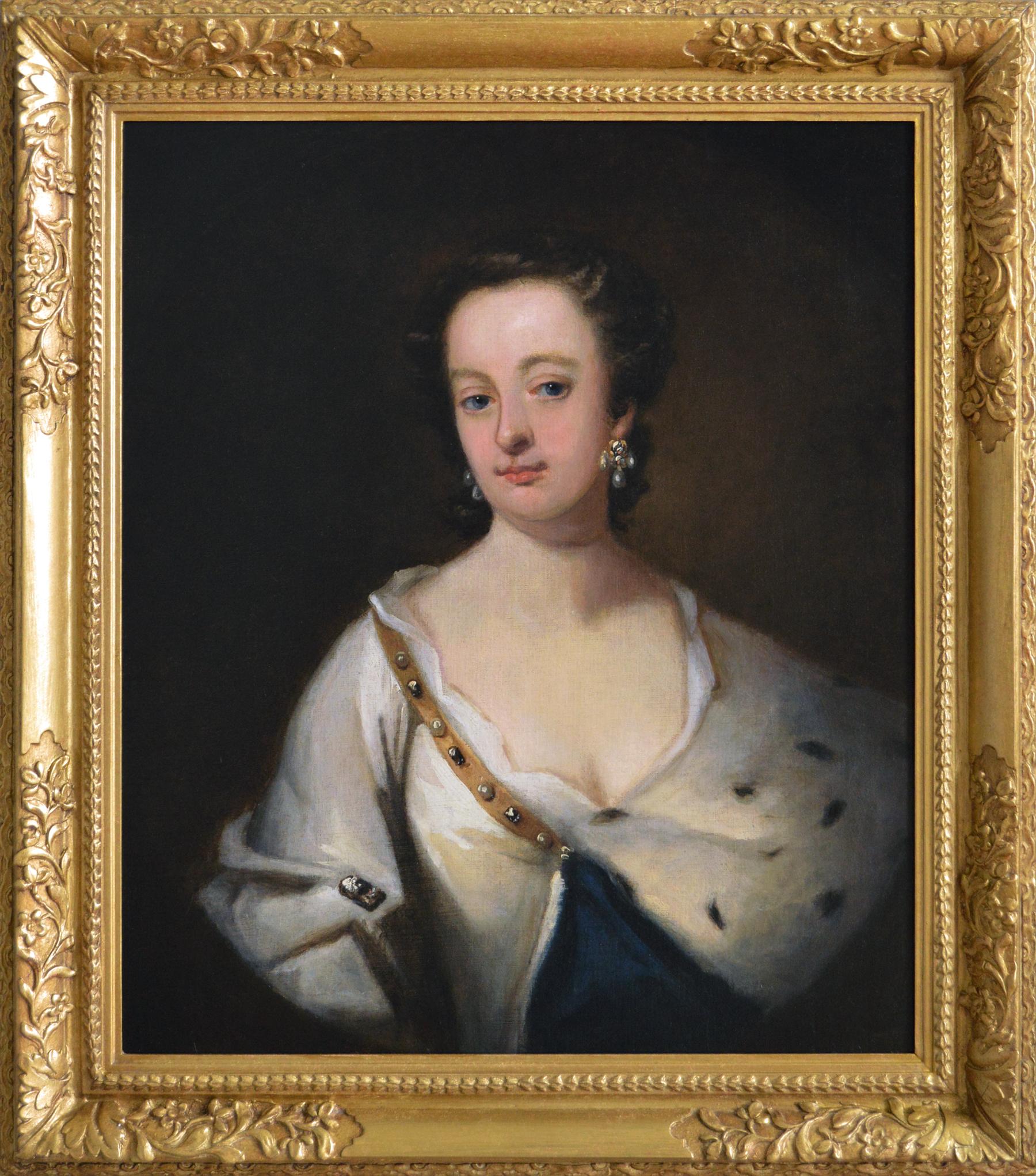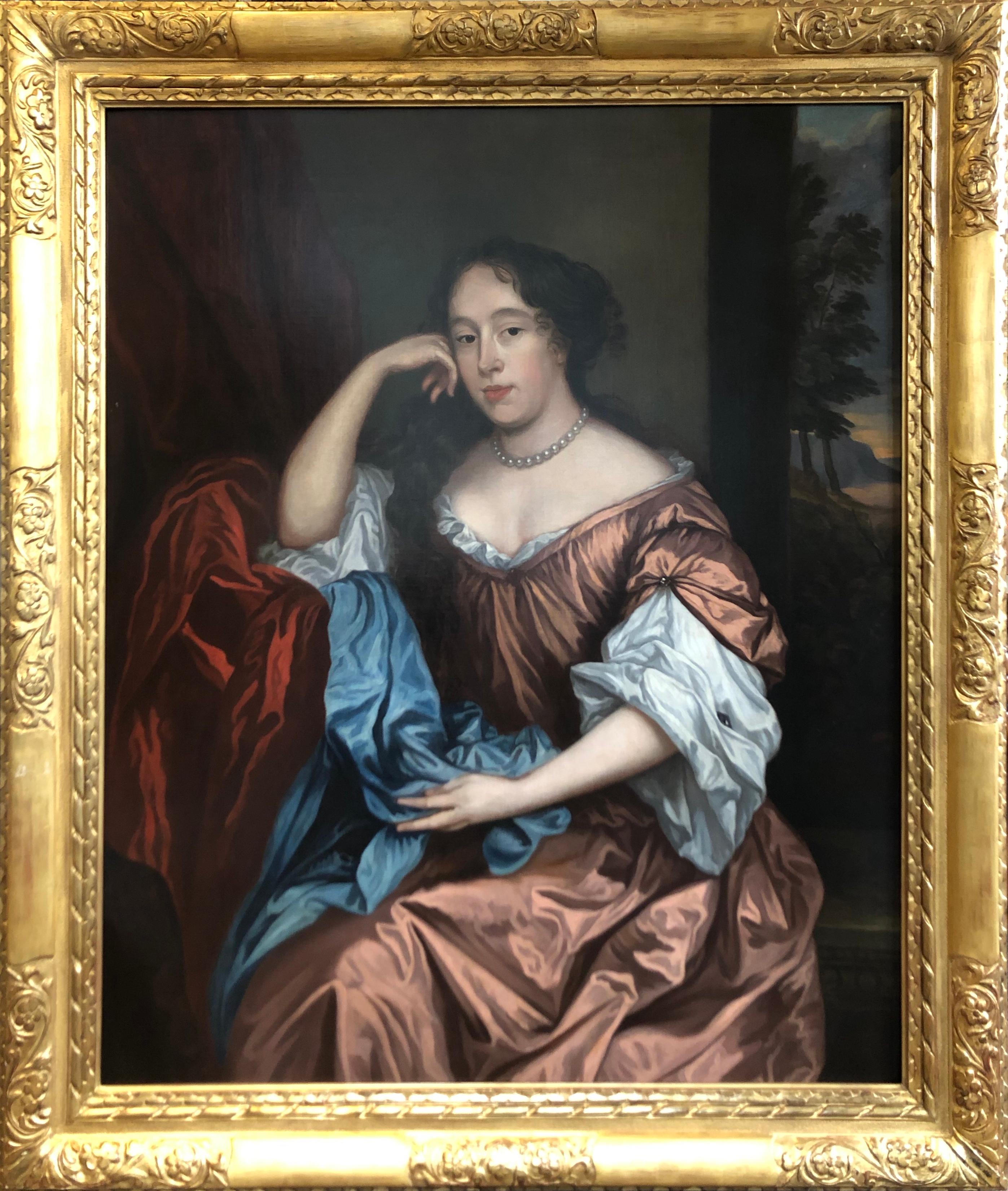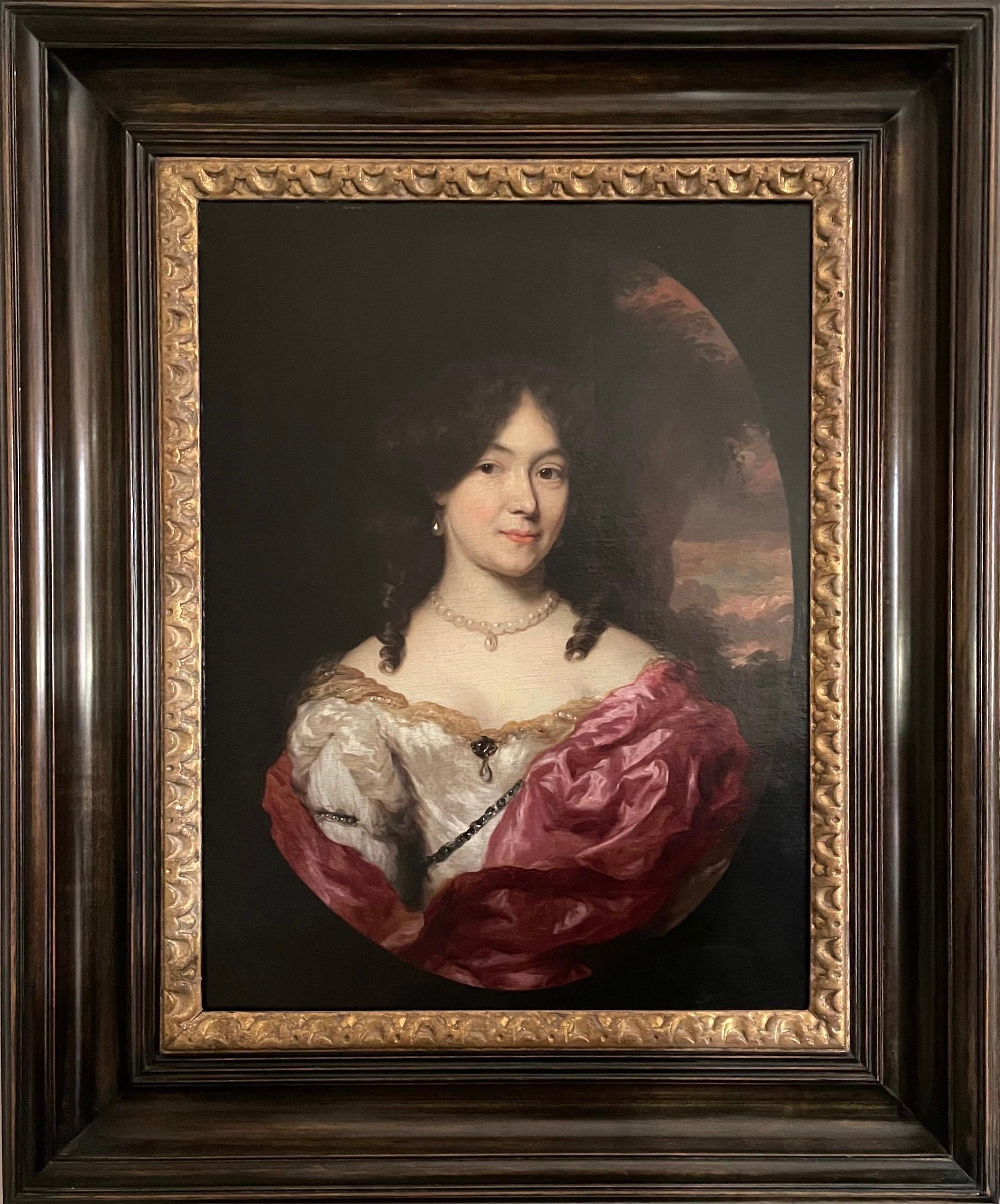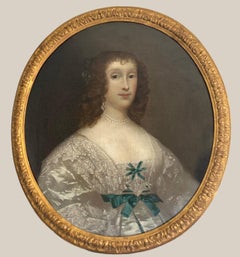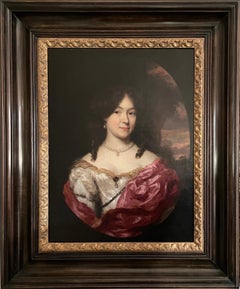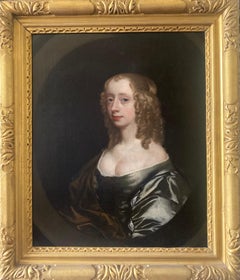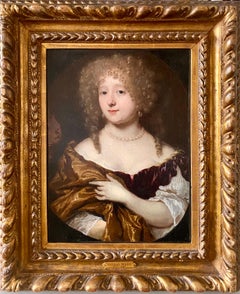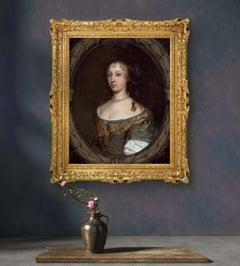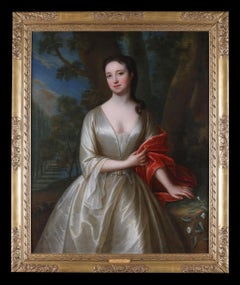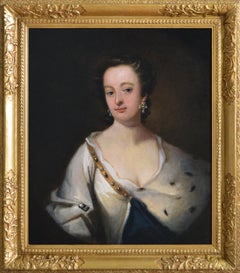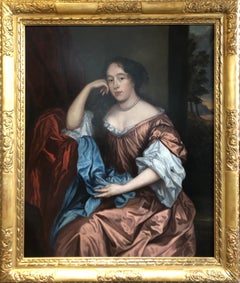Items Similar to English 17th century portrait of a lady in an ivory silk gown on a terrace
Want more images or videos?
Request additional images or videos from the seller
1 of 12
John GreenhillEnglish 17th century portrait of a lady in an ivory silk gown on a terracec.1670
c.1670
$28,504.75
$35,630.9420% Off
£20,800
£26,00020% Off
€24,266.58
€30,333.2220% Off
CA$39,044.38
CA$48,805.4820% Off
A$43,425.88
A$54,282.3420% Off
CHF 22,675.64
CHF 28,344.5520% Off
MX$528,446.71
MX$660,558.3920% Off
NOK 289,602.56
NOK 362,003.2020% Off
SEK 271,596.11
SEK 339,495.1420% Off
DKK 181,110.77
DKK 226,388.4720% Off
Shipping
Retrieving quote...The 1stDibs Promise:
Authenticity Guarantee,
Money-Back Guarantee,
24-Hour Cancellation
About the Item
Portrait of a 17th century lady, three-quarter length, in an ivory silk gown standing on a garden terrace.
The lady, painted circa 1670, gestures with her hand towards the gardens and land beyond off her country estate, wearing a sumptuous ivory silk gown adorned with pearls and precious stones and pearl earrings and necklace, signaling her wealth and status. She wears a ring on her left hand, which combined with her pale gown possibly alludes to her recent marriage. There are traces of a signature in ligature 'JG' in a lower fold of the sitter's right hand sleeve.
John Greenhill was a highly skilled and talented painter whose life and career were cut tragically short. He was born in Salisbury circa 1644 and was the son of John Greenhill, a merchant and later the local registrar and Penelope Champneys of Orchardleigh, Somerset. Greenhill's early artistic training is unknown but it is believed his first portrait was of his uncle, James Abbot of Salisbury. He moved to London in 1662 and became a pupil of Sir Peter Lely, court painter to Charles II. At the start of his career, Greenhill was hard working and ambitious and according to George Vertue was considered to be 'the most excellent of Lely's disciples'. His style was clearly influenced by Lely and Van Dyck and he progressed rapidly to leave and form his own studio.
Although he painted a variety of sitters such as James Duke of York (Dulwich Picture Gallery) and John Locke and Anthony Ashley, earl of Shaftesbury, he greatly enjoyed being at the heart of the Covent Garden theatre scene and the company and social life surrounding it and painted a great many playwrights, actors and their circle. He painted in oils but also produced a great many sketches and drawings in chalk which had become very popular at the time.
According to the diarist George Vertue, this led Greenhill to lead what he described as a 'dissolute' lifestyle and on May 1676, while returning home one evening drunk from the Vine Tavern, he fell into the gutter in Long Acre, was carried home to his lodgings in Lincoln's Inn Fields and died the same night, aged only 31. He was buried in nearby St Giles-in-the Fields. He had married young and Peter Lely gave his widow and young family an annuity to live on.
Greenhill is recognized for his skill and talent in portrait painting and his early death make the few existing portraits that he produced extremely rare. He was described in an epitaph written by his friend, the writer and actress Aphra Behn as 'The famous Greenhill'. Another writer, Bainbrigg Buckeridge, wrote in his 'Essay towards an English school' of 1706 that had he not died young, the effect of his too free living, England might have boasted a Painter who according to his beginnings, could not have been much inferior to the very best of Foreigners... whom we have always so much encourag'd in the portrait way.
Provenance: Scottish Borders private collection
Literature:
Ellis Waterhouse, 'Dictionary of 16th and 17th century British Painters', 1981
Dethloff D, 'Greenhill, John (1644?–1676), portrait painter'. Oxford Dictionary of National Biography. online version, May 2021
- Creator:John Greenhill (1646 - 1676, English)
- Creation Year:c.1670
- Dimensions:Height: 47.64 in (121 cm)Width: 40.16 in (102 cm)
- Medium:
- Movement & Style:
- Period:
- Condition:
- Gallery Location:Bath, GB
- Reference Number:1stDibs: LU95212161172
About the Seller
5.0
Vetted Professional Seller
Every seller passes strict standards for authenticity and reliability
Established in 2002
1stDibs seller since 2015
37 sales on 1stDibs
Associations
The British Antique Dealers' AssociationLAPADA - The Association of Arts & Antiques DealersInternational Confederation of Art and Antique Dealers' Associations
- ShippingRetrieving quote...Shipping from: Bath, United Kingdom
- Return Policy
Authenticity Guarantee
In the unlikely event there’s an issue with an item’s authenticity, contact us within 1 year for a full refund. DetailsMoney-Back Guarantee
If your item is not as described, is damaged in transit, or does not arrive, contact us within 7 days for a full refund. Details24-Hour Cancellation
You have a 24-hour grace period in which to reconsider your purchase, with no questions asked.Vetted Professional Sellers
Our world-class sellers must adhere to strict standards for service and quality, maintaining the integrity of our listings.Price-Match Guarantee
If you find that a seller listed the same item for a lower price elsewhere, we’ll match it.Trusted Global Delivery
Our best-in-class carrier network provides specialized shipping options worldwide, including custom delivery.More From This Seller
View All17th century portrait of lady in an ivory silk gown and lace collar
By Cornelius Johnson
Located in Bath, Somerset
Circle of Cornelius Johnson (1593-1661), a 17th century portrait of a lady, bust-length oval, wearing an ivory silk gown with blue silk bows and lace c...
Category
Early 17th Century Old Masters Portrait Paintings
Materials
Canvas, Oil
$16,442 Sale Price
25% Off
17th century portrait of a lady
By Nicolaes Maes
Located in Bath, Somerset
Portrait of a lady by Dutch Golden Age painter Nicolaes Maes (1634-1693). Half-length, within a feigned oval, the lady wears a pearl necklace and earrings, an ivory silk gown adorned...
Category
17th Century Old Masters Portrait Paintings
Materials
Canvas, Oil
English 17th century portrait of a lady
By Sir Peter Lely
Located in Bath, Somerset
A 17th century English portrait of a lady by Sir Peter Lely (1618-1680), half-length in a painted feigned oval, wearing a green silk gown with chestnut coloured cloak over one shoulder, her fair hair curled in the fashionable ringlet style of the period. Oil on canvas in an English giltwood 'Lely' frame.
We are grateful to Diana Dethloff and Catharine MacLeod (who are currently working on a Lely catalogue raisonné) for their confirmation of Lely as the artist from photograph analysis of this previously unidentified early work.
Provenance:
Private collection Nottingham until 2021
Mellors and Kirk sale December 2000, lot 1173
The sitter is likely to have been from an upper class or aristocratic family in court circles, who were the main source of Lely`s patronage. The simple composition serves to highlight the beauty of the sitter through portraying her pale decolletage and complexion, set against the gentle gaze of her blue eyes, the soft blush of her cheeks and her full red lips.
Peter Lely (1618-1680) was originally of dutch origin and became Principle Painter to the King in 1661, following in the footsteps of Van Dyck who had died in 1641. He dominated the portrait painting scene in England for over 20 years, creating a distinctive 'court look' in his work which had a strong influence on many other artists. He had an extremely successful and popular portrait practice which meant that he soon had to develop production methods that could accommodate the high demand for portraits, and also for copies and versions of them which were given as gifts to family and courtiers. The use of studio assistants was a common practice for busy artists and as with Van Dyck, Lely is known to have used specialist assistants to execute particular parts of his paintings. Artists who worked in Lely`s studio included John Baptist Gaspars who specialised in drapery painting, William Wissing, John Greenhill...
Category
17th Century Baroque Portrait Paintings
Materials
Canvas, Oil
$24,119 Sale Price
20% Off
17th century portrait of a lady
By Nicolaes Maes
Located in Bath, Somerset
Portrait of a lady richly dressed in a purple silk gown with white sleeves, a gold coloured cloak draped across one shoulder, her blonde curls worn up...
Category
17th Century Old Masters Portrait Paintings
Materials
Canvas, Oil
English 18th century portrait of Henrietta Pelham-Holles, Duchess of Newcastle.
By Charles Jervas
Located in Bath, Somerset
Portrait of Henrietta Pelham-Holles (née Godolphin) (1701-1776), Duchess of Newcastle, standing in a wooded landscape with a river beyond, three-quarter length wearing an ivory silk ...
Category
1720s Old Masters Portrait Paintings
Materials
Canvas, Oil
English 18th century portrait of a Lady and her Daughter in an interior
By (attributed to) Joseph Highmore
Located in Bath, Somerset
Portrait of a lady, three-quarter length, wearing a blue silk gown, seated in a classical interior, with her daughter in a pink gown standing beside her holding a sprig of blossom. T...
Category
Early 18th Century Old Masters Portrait Paintings
Materials
Oil
You May Also Like
Portrait of a Lady in Green Dress & Pearl Jewellery c.1660 Painting John Wright
By John Michael Wright
Located in London, GB
In this exquisite work, painted around the time of the Great Fire of London in 1666, a beautiful young woman is wearing a green dress over a white chemise and a russet-coloured scarf...
Category
17th Century Old Masters Portrait Paintings
Materials
Canvas, Oil
Portrait of a Lady possibly Frances Thynne, Lady Worsley 1673-1750 Oil on canvas
By Charles Jervas
Located in St. Albans, GB
Charles Jervas
Possibly Frances Thynne, Lady Worsley 1673-1750
Oil on Canvas
Picture Size: 50 x 40"
Outside Frame Size: 58 x 48"
1675 – 1739
Charles Jervas, who was born in Clonli...
Category
Early 1700s English School Portrait Paintings
Materials
Oil
$41,660 Sale Price
20% Off
Free Shipping
18th Century portrait oil painting of a lady in an ermine trimmed cloak
By Sir Godfrey Kneller
Located in Nr Broadway, Worcestershire
Circle of Sir Godfrey Kneller
Dutch, (1646-1723)
Portrait of a Lady in an Ermine Trimmed Cloak
Oil on canvas
Image size: 26.5 inches x 22.5 inches
Size including frame: 33.5 inches x 29.5 inches
A well-executed half-length portrait of a lady painted in a feigned oval, circle of Sir Godfrey Kneller. The use of a feigned oval was a device used in portraiture to give a sense of depth and add an intimacy to the painting, drawing your attention to the sitter.
The subject, posed without her wig in the undressed fashion of the day, wears a blue ermine trimmed blue cloak over a white silk robe...
Category
18th Century Old Masters Portrait Paintings
Materials
Canvas, Oil
Portrait of a Lady, After Sir Peter Lely (1610-1680) Oil Painting
By After Sir Peter Lely
Located in Uppingham, GB
Oil Painting After Sir Peter Lely (1610-1680) Portrait of a Lady
Housed in a Lely gold Leaf Frame.
Peter Lely:
In 1647 he became a member of the Pain...
Category
17th Century Old Masters Portrait Paintings
Materials
Oil
18th Century French Giltwood Framed Oil Painting Portrait of a Woman
Located in Queens, NY
French (18th century) oil painting portrait of a woman holding grapes sitting next to a dog in a rectangular carved giltwood frame.
Category
Antique Mid-18th Century French Empire Paintings
Materials
Giltwood, Paint
Portrait of a Lady with White Gloves - British 18thC art Old Master oil painting
By Thomas Hudson
Located in London, GB
This charming British 18th century Old Master portrait oil painting is attributed to noted portrait artist Thomas Hudson. Hudson was most prolific between 1740 and 1760 and, from 174...
Category
18th Century Old Masters Portrait Paintings
Materials
Oil
$37,275 Sale Price
20% Off
More Ways To Browse
Portraits On Ivory
Antique Portrait Ring
Portrait James Ii
Antique Silk Picture
Ivory Ring
Lady Dior Canvas
17th C Portrait
Antique English Dictionary
Drunk Art
17th Century Pearl
16th Century Portrait Oil Paintings
16th Century Scotland
Ivory Silk Gown
Antique Picture Frame Border
Lady Dior Gray
Portrait 16th Century Oil
Foldable Picture Frame
Folding Picture Frames
